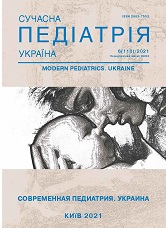Acute respiratory infections in children: current trends in antiviral therapy
DOI:
https://doi.org/10.15574/SP.2021.118.61Keywords:
children, treatment, acute respiratory viral diseases, FlavovirAbstract
The aim is тto study the clinical efficacy of Flavovir® in the treatment of acute respiratory viral infections (ARVI) in young children.
Materials and methods. The study included 60 young children who received outpatient treatment at the primary health care centers of the Vinnytsia region in the period from 2019 to 2021. The inclusion criteria for the study were ARVI and age аfrom 1 month to 3 years; exclusion criteria were еaggravated premorbid background (immunodeficiency diseases, congenital malformations, etc.), the use of other antiviral drugs, influenza vaccination.
According to this aim the children are divided into two groups. The first group consisted of 30 children with ARVI who received Flavovir® (Research and Production Company "Ecopharm" Ltd, Ukraine) in combination with symptomatic therapy. The second group consisted of 30 patients with ARVI who received only symptomatic therapy. The distribution of patients into groups was carried out randomly. The groups were representative for age, sex, structure and severity of disease.
Results. During the study the drug Flavovir® showed an effective antiviral effect in the treatment of acute respiratory viral infections in young children. In ase of the introduction of Flavovir® in the treatment regimen of the examined patients, a positive dynamics of clinical disease was noted: the intoxication syndrome disappeared three times faster (Group I — duration on average 3.4±0.2 days; Group II — 10.4±0.6 days , p<0.05), catarrhal syndrome disappeared approximately two times faster (group I — duration on average 4.5±0.4 days; II group — 9.6±0.7 days, p<0.05); нthere was a reduction in the recovery time by almost two times (group I — on average 5.81±0.5 days, II group — 11.8±0.6 days, p<0.05). The drug is well tolerated by patients and safe for children.
Conclusions. The results obtained allow to recommend Flavovir® in age-specific doses for the etiotropic therapy of modern acute respiratory viral infections in young children, taking into account the direct antiviral effect of the drug.
The study was carried out in accordance with the principles of the Declaration of Helsinki. The informed consent of the parents of the children was obtained for the research.
The author declares no conflicts of interest.
References
Beketova GV, Haytovich NV, Grinevich AI. (2014). Immunoflazid v pediatrii: sistemnyiy analiz effektivnosti i bezopasnosti primeneniya. Pediatriya. Vostochnaya Evropa. 3 (7): 141-152.
Brealey JC, Sly PD, Young PR, Chappell KJ. (2015, May). Viral bacterial co-infection of the respiratory tract during early childhood. FEMS Microbiol Lett. 362 (10): 62. Epub 2015 Apr 15. https://doi.org/10.1093/femsle/fnv062; PMid:25877546
Grynevych O, Borshov S, Matyash V, Momotiuk L, Motuzka O, Yashchenko L. (2021, Aug 16). Proteflazid® effectiveness for prevention and treatment of acute viral respiratory infections in the conditions of COVID-19. PubMed. Pol Merkur Lekarski. 49 (292): 255-265. URL: pubmed.ncbi.nlm.nih.gov/34464364//2021.
Heinonen S, Rodriguez-Fernandez R, Diaz A, Oliva Rodriguez-Pastor S, Ramilo O, Mejias A. (2019, Aug). Infant Immune Response to Respiratory Viral Infections. Immunol Allergy Clin North Am. 39 (3): 361-376. Epub 2019 May 15. https://doi.org/10.1016/j.iac.2019.03.005; PMid:31284926 PMCid:PMC6625527
Kai H, Obuchi M, Yoshida H et al. (2014). In vitro and in vivo anti-influenza virus activities of flavonoids and related compounds as components of Brazilian propolis (AF-08). J Funct Foods. 8: 214-223. https://doi.org/10.1016/j.jff.2014.03.019
Kramarev SA, Grinevich AI, Tonkovid OB, Vygovskaya OV. (2014). Meta-analysis of clinical studies on the efficacy of flavonoids in viral and viralbacterial diseases in children. Sovremennaya pediatriya. 5 (61): 39-45. https://doi.org/10.15574/SP.2014.61.39
Liu AL, Wang HD, Lee SM et al. (2008). Structure-activity relationship of flavonoids as influenza virus neuraminidase inhibitors and their in vitro anti-viral activities. Bioorg Med Chem. 16 (15): 7141-7147. https://doi.org/10.1016/j.bmc.2008.06.049; PMid:18640042
Lu SJ, Chong FC. (2012). Combining molecular docking and molecular dynamics to predict the binding modes of flavonoid derivatives with the neuraminidase of the 2009 H1N1 influenza A virus. Int J Mol Sci. 13 (4): 4496-4507. https://doi.org/10.3390/ijms13044496; PMid:22605992 PMCid:PMC3344228
MOZ Ukrainy. (2021). Instruktsiia dlia medychnoho zastosuvannia preparatu FLAVOVIR® zi zminamy. Nakaz MOZ Ukrainy vid 10.09.2021 No. 1922. URL: https://flavovir.ua/ru/instruktsiya-2/.
Ryibalko SL, Starosila DB, Zavelevich MP. (2018). Sovremennoe sostoyanie himioterapii i profilaktiki grippa i ORVI v Ukraine. Ukr Med Chasopis. 1 (123): 1-І/ІІ.
Tarahovsky Y. (2014). Flavonoid-membrane interactions: involvement of flavonoid-metal complexes in raft signaling. Biochim Biophys Acta. 1838 (5): 1235-1246. https://doi.org/10.1016/j.bbamem.2014.01.021; PMid:24472512
Tokarchuk NI. (2012). Vykorystannia Imunoflazydu dlia profilaktyky i likuvannia hrypu i HRVI u ditei pid chas sezonnoho pidvyshchennia zakhvoriuvanosti. Sovremennaya pediatriya. 1 (41): 123-127.
Ukrmedpatentinform. (2021). Informatsiinyi lyst pro novovvedennia v sferi okhorony zdorov'ia. Napriam vprovadzhennia: virusy ta virusni infektsii. Antyvirusna aktyvnist flavonoidnoho preparatu Proteflazid®. Ukrmedpatentinform. 80: 4.
Downloads
Published
Issue
Section
License
Copyright (c) 2021 Modern pediatrics. Ukraine

This work is licensed under a Creative Commons Attribution-NonCommercial 4.0 International License.
The policy of the Journal “MODERN PEDIATRICS. UKRAINE” is compatible with the vast majority of funders' of open access and self-archiving policies. The journal provides immediate open access route being convinced that everyone – not only scientists - can benefit from research results, and publishes articles exclusively under open access distribution, with a Creative Commons Attribution-Noncommercial 4.0 international license (СС BY-NC).
Authors transfer the copyright to the Journal “MODERN PEDIATRICS. UKRAINE” when the manuscript is accepted for publication. Authors declare that this manuscript has not been published nor is under simultaneous consideration for publication elsewhere. After publication, the articles become freely available on-line to the public.
Readers have the right to use, distribute, and reproduce articles in any medium, provided the articles and the journal are properly cited.
The use of published materials for commercial purposes is strongly prohibited.

